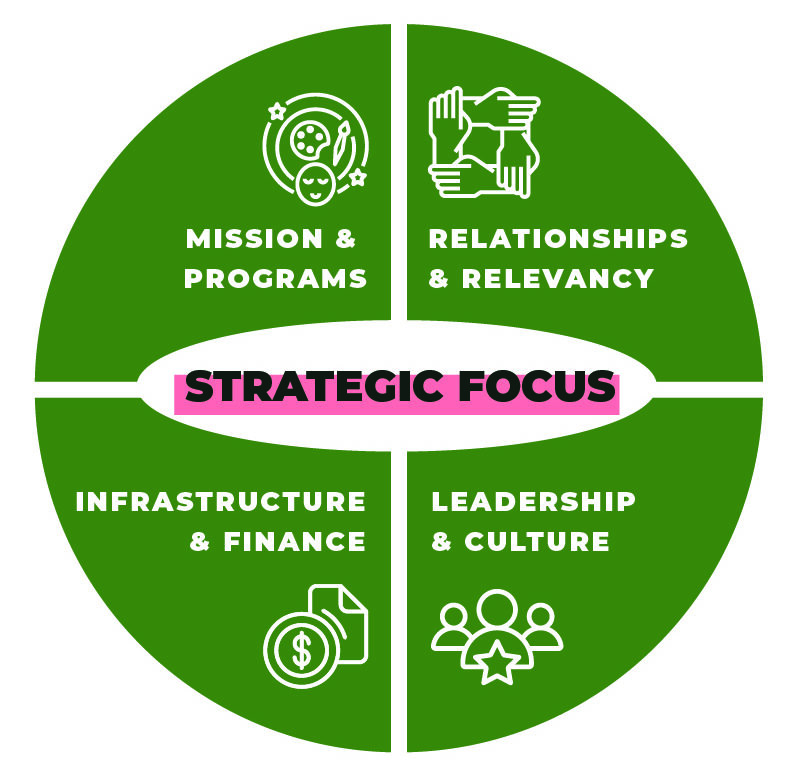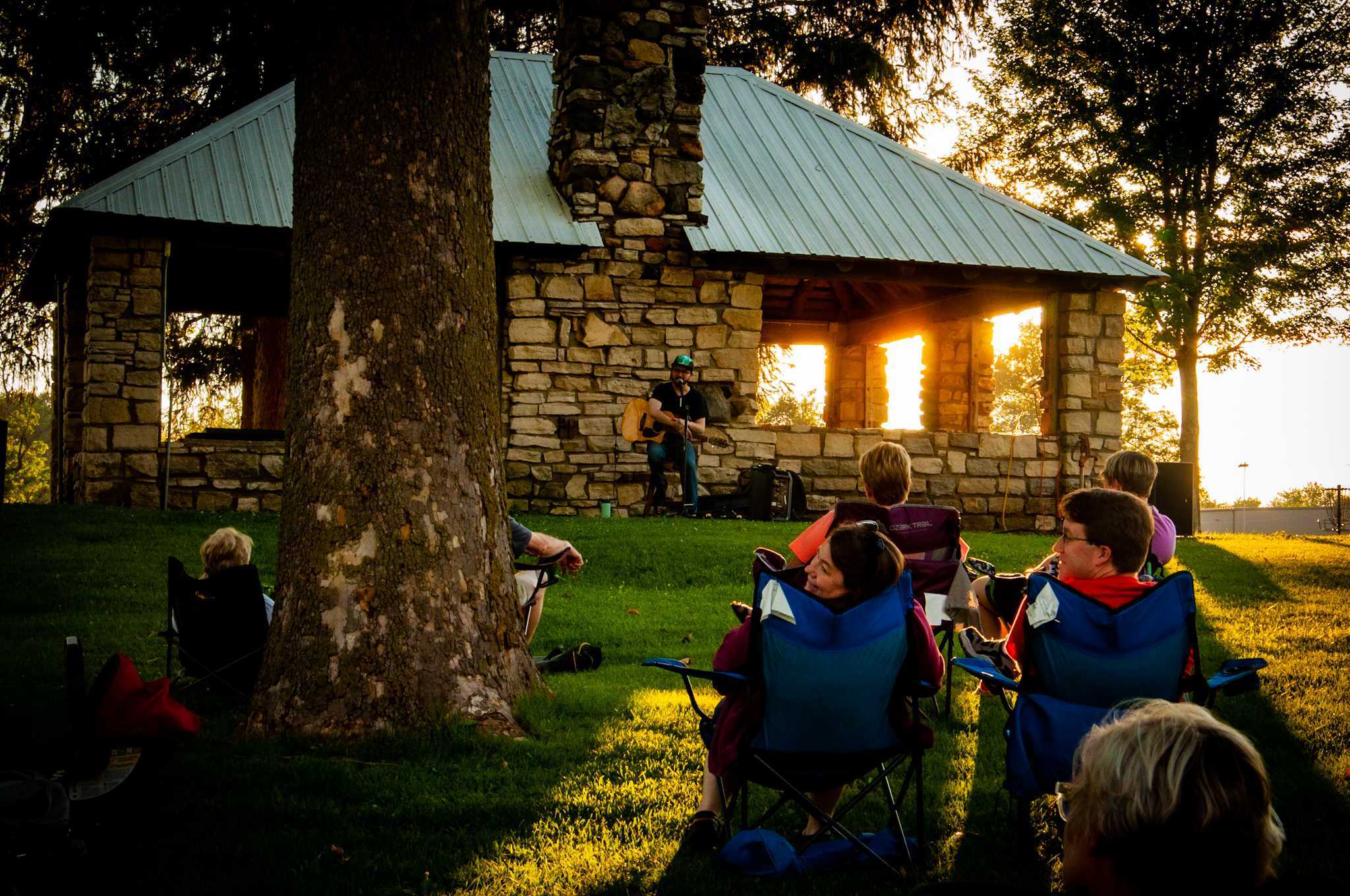Identifying your organization’s strengths and challenges is essential to effective planning. Though not as flashy as the evaluations that measure your external impact, this internal work is equally as important. Understanding the internal capacity of your operations will help you set stronger, more attainable goals and will ultimately, in turn, move the needle on your organization’s external impact.

Using our capacity self-assessment
This capacity assessment is organized around the five key strategic sections of the model introduced in Building a Healthy Arts Organization. Completing the assessment with your team may help you identify trends and opportunities for your organization.
This assessment is specifically made for arts and culture organizations, and the unique roles they play in their community. But, it can be modified to fit the needs of any organization!
Let’s get started
On a scale of 1-4, rate your agreement with the following statements:
- Our organization has a clear, concise mission statement that communicates its reason for existence, and is known broadly inside and outside of the organization.
- Our organization has a compelling vision that communicates what we aspire to accomplish and it is known broadly inside and outside of the organization.
- Our organization has a set of articulated values or guiding principles that define it and are key to our functioning and decision-making.
- Our organization knows its strengths and unique advantages and builds upon these to create a stronger future.
- Our organization has a current written strategic plan, approved by the Board of Directors, with clear and agreed-upon long term goals to set direction.
- Our strategic plan is revisited at least annually and adapted to meet changing circumstances both within our organization and in the broader community served.
- Our strategic goals and objectives are understood throughout the organization and used to guide decision making at all levels.
- Our organization has a clearly defined programming vision that aligns with the needs and interests of our clearly defined target audience(s).
- All of our programs are based on clear community needs and are responsive to evolving community needs; gaps are assessed to determine these needs.
- Our organization asks for and receives feedback from our target community about their experiences of and perceived barriers to programming, and acts upon that feedback.
- Our program venues are inviting and accessible to target audiences.
- When applicable, our organization effectively collaborates in developing and implementing programs that advance the missions of each collaborating organization.
- Programming plans are inspired by our mission, vision, and values.
- Programming plans are realistic given our operational needs and capacity.
- Over the past year, our programs met their goals, or were changed so that we could meet them in the future.
- Our organization understands what might influence different audiences’ decisions to participate and we use this knowledge to inform outreach and program planning.
- Our organization has strategies to deepen its current participants’ level of involvement in the organization, through enriched experiences or more opportunities for involvement.
- Our organization has strategies to attract more participants similar to those already participating in the organization through a variety of activities to broaden involvement.
- Our organization has strategies to reach new audiences, including those from population groups that may have been marginalized in the past, in an effort to diversify participation.
- Our organization is strategic about forming partnerships to increase participation in its programs.
- Our programming is designed with a goal of removing barriers, such as cultural, economic, accessibility, educational, and transportation.
- Our organization’s strategic planning takes changing community demographics and needs into consideration.
- Our organization has a wide circle of contacts from the community that it can call upon for support in building the identity and strength of the organization.
- Our organization is known within our community and perceived as actively engaged with and responsive to our community. Community leaders call upon our organization.
- Our organization has a financial plan that forecasts financial requirements at least 2-3 years into the future. Realistic yet demanding targets exist for resources tied to organizational strategic goals.
- Our organization has an annual budget in place that reflects the organization’s strategic and operational goals. The budget is reviewed and approved by the board in advance at the beginning of each fiscal year.
- Our organization is funded through a diverse mix of contributed income (public, foundation, corporate, and individual) and earned income.
- Our challenging yet achievable annual fundraising goals are set & reviewed at the end of each fiscal year.
- Realistic plans are developed regarding our potential staffing needs, tied to strategic planning, including planning for succession or transitions of staff.
- All staff receive training or professional development to stay up-to-date and expand their capabilities.
- Staff members have annual work plans with clear and challenging goals, linked to the organization’s strategic goals. Staff members are evaluated in writing regularly against goals agreed upon in their work plan.
- Someone is responsible for human resource management, including legal obligations and appropriate compensation of all personnel.
- Our organization has a written communications strategy and plan with key messages, target audiences, and approaches to delivery.
- Our physical space is adequate for the current needs of our organization. Our infrastructure is maintained and does not limit effectiveness.
- Our organization recruits and manages volunteers systematically, and assigns responsibility to specific people to manage and provide volunteers with meaningful work.
- Software and reporting systems are utilized to track our financial information, program outcomes, clients, and volunteers. Systems are up-to-date.
- Funds are set aside for our facility maintenance and technology upgrades; routine maintenance and technology upgrades are a part of our organizational culture.
- Artist fees, salaries, and benefits are at a level appropriate for our industry and our organization, and they communicate respect for artistic expertise and encourage allegiance.
- Our organization embraces a culture of learning, with processes in place to support knowledge sharing and the incorporation of diverse perspectives from inside and outside the organization.
- Our organization has systems in place to track our progress and input from various stakeholders. Evaluation is a part of our organization’s culture and is used regularly in program, financial, and organizational planning.
- Staff and board members understand our organization’s business model and have the opportunity to share and discuss meaningful and timely financial information.
- Our board has an adopted set of bylaws, a committee structure, and defined roles and responsibilities for each member.
- New board members are given a thorough orientation to our organization, the board, and their governance responsibilities—legal, fiduciary, and strategic.
- Our board is representative of our community and alert to changing community needs and realities.
- Attendance at board meetings is consistently high.
- Our board works with the executive director to set goals for the executive that are strategic, and the board assists the executive director in achieving them.
- Our board works outside of board meetings to advance the organization in achieving strategic objectives.
- Our organization’s board consistently acts as a strategic resource, demonstrating commitment to the organization’s success, mission, vision, and values by establishing performance targets and evaluation benchmarks.
- The relative roles of our board and staff are defined and boundaries are respected, with the executive director as operations manager and the board focused on policy, planning and fiduciary oversight.
- Power issues that may exist between board and staff (or staff and staff) are regularly acknowledged and discussed; policies and procedures exist to address these issues.
Try it for yourself
Are you feeling inspired? It’s time to try it out using our worksheet.
PDF Word Document-
1
Prepare for the assessment
Set up the assessment in either a web-based or paper-based version to allow for anonymity. You can customize some of the questions or create new ones.
Pro tip: Set the questions up on a scale from 1-4 to prevent folks from being too non-committal in their responses. Using an even number of options requires people to state whether they lean toward agreeing or disagreeing with the statement. It’s also important to include a “N/A or Don’t Know” response, as not everyone will have knowledge or experience of each section.
-
2
Take the assessment yourself first
This will help you identify who else would be good to ask.
-
3
Gather key folks
Identify 10-20 individuals who work with the organization as administrative or artistic staff (employees or contractors), board members, or volunteers. Send an initial email request to the people on your list. Be sure to communicate a deadline for completion.
Here’s a sample email that you can adapt for your needs:
You are a key stakeholder with knowledge and insight into the workings of this organization, so we hope you will agree to complete this 10 minute assessment to share your wisdom to aid our planning efforts. Please embrace this opportunity to identify areas of strength and also potential areas of growth. Try not to inflate your responses out of a sense of loyalty. Your response, which will be anonymous, will help us identify areas where we can focus our future efforts.
-
4
Collect assessments
Compile responses submitted by your staff, board, and volunteers. Create a report showing average scores for each question, as well as average scores for each whole section.
-
5
Review results as a team
Hold a meeting with your planning team to review and interpret the results and identify further questions or goals for your work. See the conversation guide below.
Dig a bit deeper into your results
Using the scale from 1-4, with 4 being “Strongly Agree”, note any scores where there was less than an average of 3 (or “Agree”), as this indicates at least some concern in this area. Additionally, note which questions received 20% “N/A or Don’t know” responses. This can be illuminating.
As you review, keep in mind:
It’s not unusual for reports to show the lowest scores in the Resources and Infrastructure section. This remains a challenge for many nonprofits, as well as an opportunity for organizational development.
Similarly, it’s quite common for the highest rate of “N/A or Don’t Know” responses in the Leadership and Culture section, as not everyone needs to know about how the board operates.
Finally, a small sample size means that the result doesn’t show the whole picture, and isn’t statistically significant. These results simply begin to give you a picture of how the people closest to your organization view its operations at this moment in time.
Pro Tip: Low scores in a section don’t necessarily mean that the organization is doing something wrong.
The score may be entirely expected given the life stage your organization is in, or could be explained by a lack of clear communication. You can glean value from digging into scores that might come as a surprise in order to understand them.

Keep the conversation going
Schedule 1-2 hours to review this report with your team. You may wish to follow this guide to discuss each section. Don’t forget to take notes on your conversation!
-
Overview Questions
- What percentage of people who you invited to take the survey followed through? If you asked respondents to identify themselves, is there anything that surprises you about who did (or did not) respond to the assessment?
- Calculate an average score for each of the 5 capacity sections. What do you notice? Do these scores reflect your gut impression of how your organization is doing in these sections? Which sections seem to be strengths? And which sections seem to require more focus?
-
Questions to discuss for each of the five sections
- At first glance, what do you notice in these responses? What surprised you?
- What questions does this raise for you?
- Where do you agree or disagree with the responses of others? If you disagree, what might this mean, or what might have caused these results?
- What do you take away from this in terms of things you may wish to focus on?
